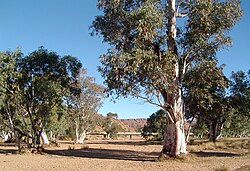
Mitta Mitta River, a perennial river and a direct tributary of the Murray River within the Murray–Darling basin, is located in the Alpine district of Victoria, Australia.
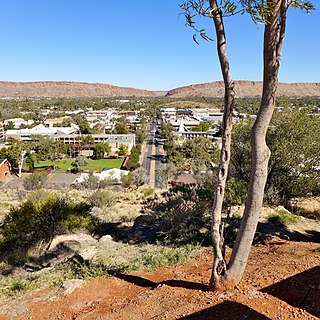
Alice Springs, is the second-largest town in the Northern Territory, Australia. The name Alice Springs was given by surveyor William Whitfield Mills after Alice, Lady Todd, wife of the telegraph pioneer Sir Charles Todd. Known colloquially as 'The Alice' or simply 'Alice', the town is situated roughly in Australia's geographic centre. It is nearly equidistant from Adelaide and Darwin.
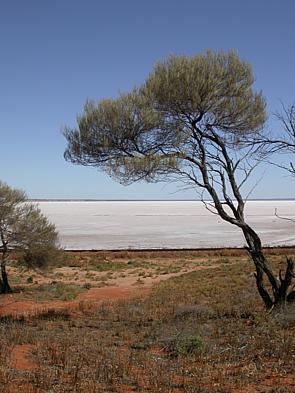
The Lake Eyre basin is a drainage basin that covers just under one-sixth of all Australia. It is the largest endorheic basin in Australia and amongst the largest in the world, covering about 1,200,000 square kilometres (463,323 sq mi), including much of inland Queensland, large portions of South Australia and the Northern Territory, and a part of western New South Wales. The basin is also one of the largest, least-developed arid zone basins with a high degree of variability anywhere. It supports only about 60,000 people and has no major irrigation, diversions or flood-plain developments. Low density grazing that sustains a large amount of wildlife is the major land use, occupying 82% of the total land within the basin. The Lake Eyre basin of precipitation to a great extent geographically overlaps the Great Artesian Basin underneath.
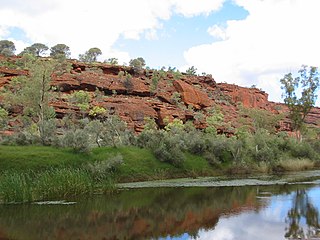
The Finke River, or Larapinta in the Indigenous Arrernte language, is a river in central Australia, whose bed courses through the Northern Territory and the state of South Australia. It is one of four main rivers of the Lake Eyre Basin and thought to be the oldest riverbed in the world. It flows for only a few days a year. When this happens, its water usually disappears into the sands of the Simpson Desert, rarely if ever reaching Lake Eyre.

A water gap is a gap that flowing water has carved through a mountain range or mountain ridge and that still carries water today. Such gaps that no longer carry water currents are called wind gaps. Water gaps and wind gaps often offer a practical route for road and rail transport to cross the mountain barrier.
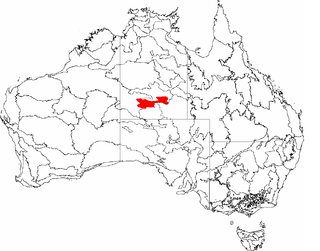
The MacDonnell Ranges, or Tjoritja in Arrernte, is a mountain range located in southern Northern Territory. MacDonnell Ranges is also the name given to an interim Australian bioregion broadly encompassing the mountain range, with an area of 3,929,444 hectares. The range is a 644 km (400 mi) long series of mountains in central Australia, consisting of parallel ridges running to the east and west of Alice Springs. The mountain range contains many spectacular gaps and gorges as well as areas of Aboriginal significance.
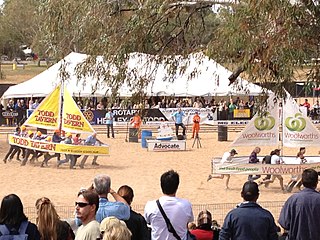
The Henley-on-Todd Regatta is a "boat" race held annually in the typically dry sandy bed of the Todd River in Alice Springs, Australia.
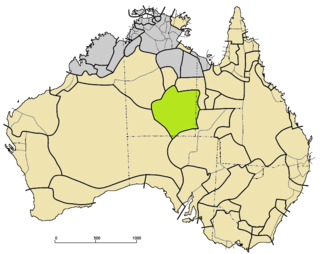
Arrernte or Aranda or sometimes referred to as Upper Arrernte, is a dialect cluster in the Arandic language group spoken in parts of the Northern Territory, Australia, by the Arrernte people. Other spelling variations are Arunta or Arrarnta, and all of the dialects have multiple other names.

The Arrerntepeople, sometimes referred to as the Aranda, Arunta or Arrarnta, are a group of Aboriginal Australian peoples who live in the Arrernte lands, at Mparntwe and surrounding areas of the Central Australia region of the Northern Territory. Many still speak one of the various Arrernte dialects. Some Arrernte live in other areas far from their homeland, including the major Australian cities and overseas.
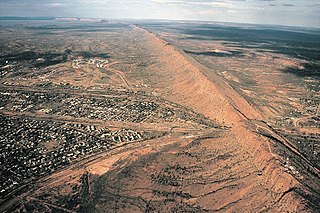
The Heavitree Gap, or Ntaripe in the Arrernte language, is a water gap in the Northern Territory of Australia in the MacDonnell Ranges. It is the southern entrance to the city of Alice Springs and in addition to the Todd River it carries the main road and rail access to the south.

Hann Range is a mountain range in the Northern Territory of Australia located in central Australia approximately 120 kilometres (75 mi) north of Alice Springs.

The Alice Springs Telegraph Station is located within the Alice Springs Telegraph Station Historical Reserve, four kilometres north of the Alice Springs town centre in the Northern Territory of Australia. Established in 1872 to relay messages between Darwin and Adelaide, it is the original site of the first European settlement in central Australia. It was one of twelve stations along the Overland Telegraph Line.
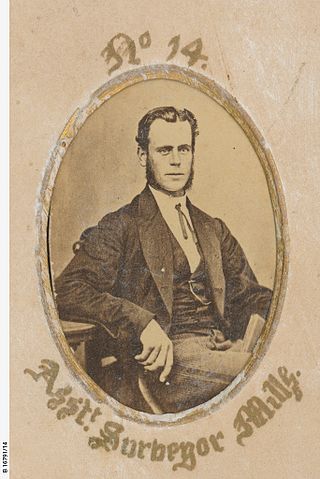
William Whitfield Mills, usually referred to as "W. Whitfield Mills" or "W. W. Mills", was an English surveyor of the Australian Overland Telegraph Line who is best known for naming a waterhole in Central Australia Alice Spring, from which the town of Alice Springs now takes its name. He also named Heavitree Gap as a tribute to his old school in Devon, England.
Doris Stuart Kngwarreye is the senior traditional owner for Mparntwe in the Northern Territory of Australia.

Heavitree Gap Police Station is a historic building within the Heavitree Gap Police Station Historical Reserve. It is located on the southwestern side of Heavitree Gap in Alice Springs in the Northern Territory of Australia.
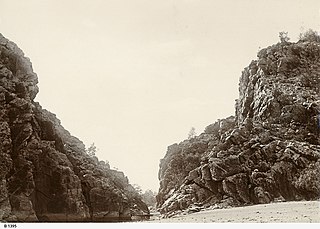
Emily Gap / Anthwerrke is a natural attraction and significant cultural site in the East MacDonnell Ranges, eight kilometres to the east of Mparntwe/Alice Springs, in Australia's Northern Territory.
The Charles River, which is often called Charles Creek is an ephemeral river in the southern Northern Territory. It is a tributary of the Todd River and, like the Todd River, its naming is associated with Charles Todd; a senior civil servant involved with the Overland Telegraph Line.
Honeymoon Gap is a small gap 1 km south of Larapinta Drive, 14 km west of Alice Springs, on Roe Creek, 8 km south of where it cuts through Simpsons Gap.
Amelia Kunoth née Pavey was an Aboriginal Australian woman who developed well-known cattle stations in Central Australia, including Utopia, Bond Springs, Hamilton Downs and Tempe Downs.
